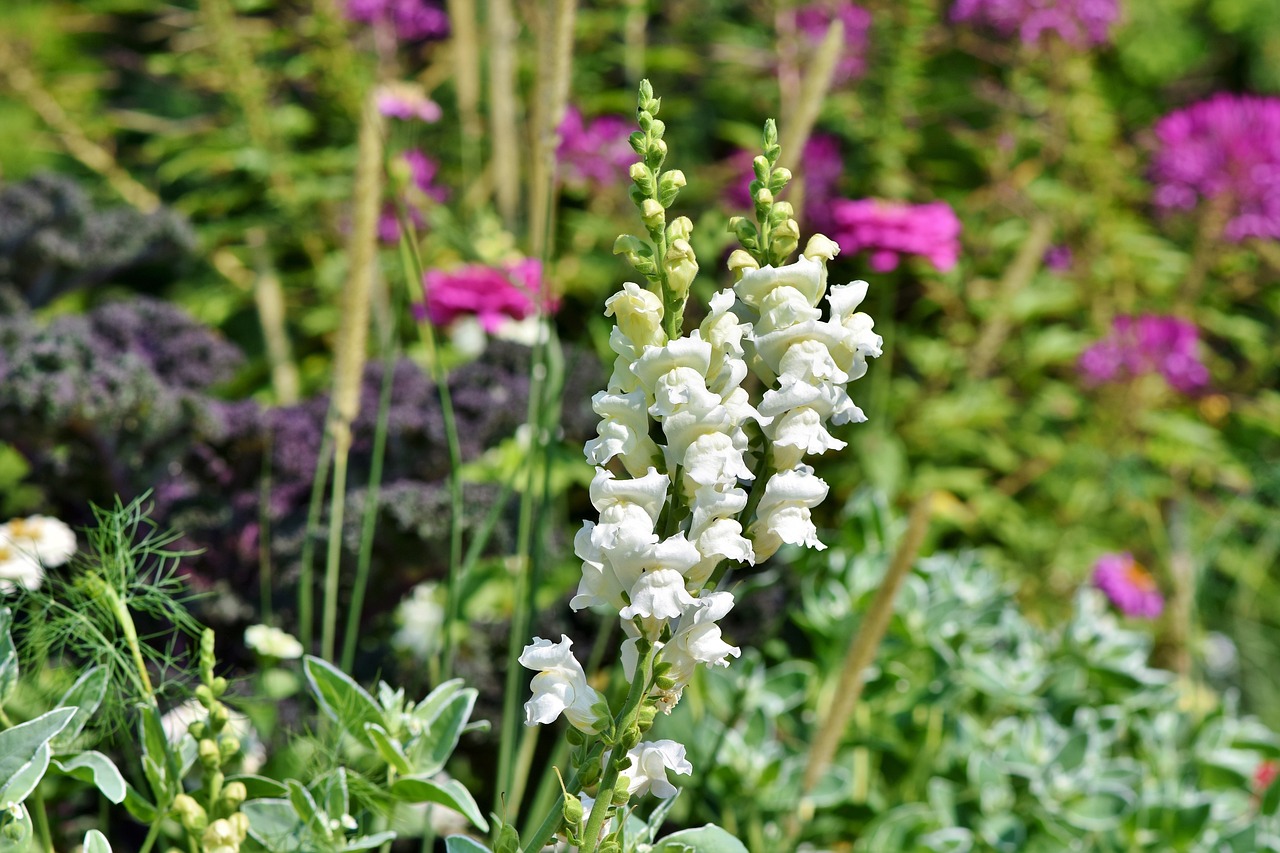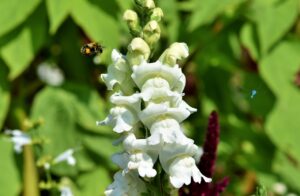Snapdragon
Overview
The Snapdragon, known botanically as Antirrhinum majus, is a vibrant flowering plant that enlivens gardens with its richly colored blooms in spring or fall. While primarily ornamental, these beauties have a symbiotic relationship with bumblebees for pollination and thrive in cooler climates. Their lush array of hues and easy-care nature make them a beloved addition to any floral setting.

Characteristics
Known for its jaw-like flowers which require large bumblebees for pollination, vibrant color range, and preference for cool weather conditions.
Region
Commonly grown in temperate regions around the world.
Natural Habitat
In the wild, it is typically found on rocky areas, old walls, and castle ruins.
Cultivation
Prefers full sun to partial shade, moderate watering once established, and well-drained soil with a neutral to slightly acidic pH.
Uses and Benefits
Snapdragons, with their lively blooms in a rainbow of colors, are a visual treat in any garden setting. While they may not be known for culinary or medicinal uses, their ornamental value is undeniable. These charming flowers bring a touch of whimsy to gardens and are a favorite in the floral industry due to their wide range of vibrant hues and horticultural varieties2. When snapdragons bloom in the cool seasons of spring or fall, they’re not just a feast for the eyes—they also play a unique role in the garden’s ecosystem. Bumblebees, rather than smaller bees, are essential to their pollination process, as they have the strength to pry open the Snapdragon’s distinct “jaw-like” petals1. This symbiotic relationship highlights the importance of considering local pollinators when growing these delightful plants.

Cultivation Tips
To ensure your Snapdragons flourish, it’s important to remember that they are cool-weather lovers; aim to plant them in the welcoming arms of either spring or fall. Given the Snapdragon’s special relationship with pollinators, specifically bumblebees, be mindful of their presence in your garden; these hefty insects are key to the flowers’ propagation as they have the unique ability to pry open the Snapdragon’s blossom “jaws” to pollinate them1.
Plant them as annuals in most regions, or perennials in milder climates, where the winters are not as harsh. They’ll grace you with a spectrum of vibrant blooms that will add a pop of color to your garden during the cooler parts of the year. Since Snapdragons enjoy the milder temperatures, it is essential to avoid the summer’s scorching heat, which could hinder their growth and lessen their blooming potential. No particular concerns regarding companion planting or pests are noted, so feel free to experiment with their placement among your garden’s flora.
Seasonal Considerations
Snapdragons enchant the garden twice a year, unfurling their colorful petals when the weather is on the cooler side. Whether they grace your beds in spring’s gentle warmth or brighten the dwindling days of fall, these blooms are seasonal stars. This affinity for milder temperatures is not just about aesthetics—it’s about plant health and vibrancy1. So, when planning your garden calendar, circle the cooler months; that’s when your snapdragons will perform their best, launching a vivid display that brings your garden to life. It’s also the perfect moment to witness their unique pollination dance with bountiful bumblebees, essential for snapdragon success.

Issues and Troubleshooting
Snapdragons, with their vivid blooms, can occasionally run into a few hiccups. If your Snapdragons aren’t flourishing, consider whether they might be feeling a bit too warm; these plants prefer the milder temperatures of spring and fall1. Make sure they’re not overcrowded, as good air circulation is key to keeping them healthy. Also, be vigilant about watering – these beauties like their soil moist, but not waterlogged.
Keep an eye out for common pests such as aphids and spider mites which can cause damage if left unchecked. If you notice your Snapdragons struggling, a gentle treatment with insecticidal soap can help ward off these unwelcome visitors. Remember that Snapdragons rely on larger pollinators like bumblebees, so if bees are scarce in your area, this could affect the plant’s ability to set seed and thus continue its lifecycle1. With the right care, you can keep common issues at bay and enjoy the full, vibrant potential of these captivating flowers.
History and Folklore
In the corridors of history and the gardens of folklore, the Snapdragon plant, or Antirrhinum majus, has been a source of whimsy and myth. Nestled within the tales of old, it’s believed that these flowers were thought to possess supernatural powers and could protect against deceit and curses when planted. The ‘dragon’s mouth’ of the snapdragon was associated with both protection and enchantment—closing its floral jaws on the fingers of anyone bold enough to pinch the bloom.
In some traditions, carrying a snapdragon was said to confer gracefulness and civility upon its bearer, and the plant also featured in various rituals and was considered a symbol of graciousness and strength.
Though details of its early cultivation are less known, the enchanting snapdragon has certainly captured the imagination across centuries, lending an air of enduring mystery to its vibrant presence in the natural world.
References
1. Snapdragons: Plant Care & Growing Guide – The Spruce, https://www.thespruce.com/growing-and-caring-for-snapdragons-1402915
2. Snapdragon | Plant, Flower, & Facts | Britannica, https://www.britannica.com/plant/snapdragon
3. Antirrhinum – Wikipedia, https://en.wikipedia.org/wiki/Antirrhinum
4. Antirrhinum majus – Wikipedia, https://en.wikipedia.org/wiki/Antirrhinum_majus
5. Snapdragon – Antirrhinum majus – PNW Plants – Washington State University, http://www.pnwplants.wsu.edu/PlantDisplay.aspx?PlantID=119
Image Credit: Ralphs_Fotos
Image Credit: Ralphs_Fotos
Image Credit: manfredrichter
Nicolas Duval
Nicolas is a passionate advocate for nature and the art of wildcrafting. His dedication shines through in Wildcraftia, a website he meticulously crafted to serve as a haven for nature enthusiasts worldwide. Driven by a deep appreciation for nature’s connection to humanity, Nicolas embarked on his journey in 2011 with SmokableHerbs, a platform showcasing his love for nature’s bounty. Building upon this foundation, he established Smokably, a thriving online store offering premium herbs and blends to a global audience.
